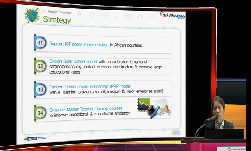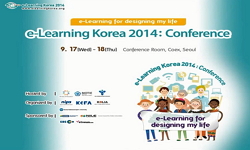본 연구는 이러닝 환경에서 대학생의 배경변인과 학습스타일에 따라서 이러닝 학습전략에 차이가 있는가에 대해 연구하였다. 이를 위하여 경북소재 Y대학교의 대학생 629명을 연구대상으로 ...
http://chineseinput.net/에서 pinyin(병음)방식으로 중국어를 변환할 수 있습니다.
변환된 중국어를 복사하여 사용하시면 됩니다.
- 中文 을 입력하시려면 zhongwen을 입력하시고 space를누르시면됩니다.
- 北京 을 입력하시려면 beijing을 입력하시고 space를 누르시면 됩니다.
이러닝 환경에서 대학생의 배경변인, 학습스타일과 이러닝 학습전략에 관한 연구 = A Study on Background Variables, Learning Styles and e-Learning Strategies of University Students in e-Learning Environment
한글로보기https://www.riss.kr/link?id=T11731130
- 저자
-
발행사항
서울 : 숙명여자대학교 원격대학원, 2009
-
학위논문사항
학위논문(석사) -- 숙명여자대학교 원격대학원 , 원격교육공학전공 원격교육공학 , 2009. 8
-
발행연도
2009
-
작성언어
한국어
- 주제어
-
발행국(도시)
서울
-
형태사항
ⅵ, 100 p. ; 26 cm
-
일반주기명
지도교수: 유평준
- 소장기관
-
0
상세조회 -
0
다운로드
부가정보
국문 초록 (Abstract)
첫째, 이러닝 환경에서 대학생의 학습스타일은 연구대상자 629명 중 분산자 521명(82.8%), 융합자 58명(9.2%), 적응자 42명(6.7%), 수렴자 8명(1.3%)으로 이러닝 학습자의 학습스타일이 뚜렷하게 구별되어 나타났다.
둘째, 이러닝 환경에서 대학생 이러닝 학습전략은 11개의 하위 이러닝 학습전략 중에서 자신감입증전략(M=4.16, SD=.86)의 활용 수준이 가장 높게 나타난 반면 표현전략(M=2.98, SD=.75)이 가장 낮았다.
셋째, 이러닝 학습자의 배경변인(성별, 학년, 이러닝 참여경험, 이러닝 접속장소, 학습시간)에 따른 대학생의 이러닝 학습전략 활용 수준의 차이를 살펴보았다. 1) 성별 이러닝 학습전략에서는 자기주도적전략, 표현전략, 다중토론관리전략, 사회성전략, 과부관리전략, 정보처리전략, 비동시성관리전략, 정보해독전략, 긍정적 태도수립 전략 등 9개 전략에서 남학생이 여학생보다 활용 수준이 높았다. 2) 학년별 이러닝 학습전략에서는 자기주도전략, 표현전략, 다중토론관리전략, 사회성전략, 과부하관리전략, 정보처리전략, 비동시성관리전략, 시간관리전략, 정보해독전략 등 9개 전략에서 2학년이 1학년보다 높았다. 3) 계열별 이러닝 학습전략에서는 자기주도전략, 표현전략, 사회성전략, 과부하관리전략, 정보처리전략, 비동시성관리전략 등 6개 전략에서 사회계열이 자연계열보다 활용 수준이 높았다. 다중토론관리전략에서는 사회계열보다 인문계열이나 공학계열 활용 수준이 높았다. 4) 이러닝 접속장소별 이러닝 학습전략은 시간관리전략에서 심리적 안정감이 있는 학교나 집이 PC방보다 활용 수준이 높았다.
넷째, 학습스타일에 따른 이러닝 학습전략 활용 수준의 차이는 과부하관리전략(F=2.996 p=.030)에서 적응자가 분산자보다 높았다.
본 연구 결과는 이러닝 환경에서 이러닝 학습전략이 성별, 학년, 계열, 장소 등 학습자 배경변인과 학습자의 학습스타일에 따라 차이가 존재하므로 효율적인 이러닝 학습을 위해 교수-학습 환경 설계 시 학습자 개별특성을 고려한 이러닝 학습전략의 적용이 필요함을 시사하고 있다. 이를 바탕으로 학습자의 배경변인과 학습스타일에 따라 이러닝 학습전략을 적용하여 다양한 이러닝 교수학습모형 개발이 앞으로의 연구에서 더 진행되어져야 할 부분이다. 후속 연구를 통해 이러닝 학습전략을 훈련시킨 후, 학습스타일에 따라 학습자들이 사용하고 있는 이러닝 학습전략이 영향을 받는지에 대해 알아볼 필요가 있다.
본 연구는 이러닝 환경에서 대학생의 배경변인과 학습스타일에 따라서 이러닝 학습전략에 차이가 있는가에 대해 연구하였다. 이를 위하여 경북소재 Y대학교의 대학생 629명을 연구대상으로 Kolb의 학습스타일 검사지(LSI)와 이인숙(2002)의 이러닝 학습전략검사 도구를 이용하여 설문조사하였다. 설문 조사 결과 도출된 중요한 사항들은 다음과 같다.
첫째, 이러닝 환경에서 대학생의 학습스타일은 연구대상자 629명 중 분산자 521명(82.8%), 융합자 58명(9.2%), 적응자 42명(6.7%), 수렴자 8명(1.3%)으로 이러닝 학습자의 학습스타일이 뚜렷하게 구별되어 나타났다.
둘째, 이러닝 환경에서 대학생 이러닝 학습전략은 11개의 하위 이러닝 학습전략 중에서 자신감입증전략(M=4.16, SD=.86)의 활용 수준이 가장 높게 나타난 반면 표현전략(M=2.98, SD=.75)이 가장 낮았다.
셋째, 이러닝 학습자의 배경변인(성별, 학년, 이러닝 참여경험, 이러닝 접속장소, 학습시간)에 따른 대학생의 이러닝 학습전략 활용 수준의 차이를 살펴보았다. 1) 성별 이러닝 학습전략에서는 자기주도적전략, 표현전략, 다중토론관리전략, 사회성전략, 과부관리전략, 정보처리전략, 비동시성관리전략, 정보해독전략, 긍정적 태도수립 전략 등 9개 전략에서 남학생이 여학생보다 활용 수준이 높았다. 2) 학년별 이러닝 학습전략에서는 자기주도전략, 표현전략, 다중토론관리전략, 사회성전략, 과부하관리전략, 정보처리전략, 비동시성관리전략, 시간관리전략, 정보해독전략 등 9개 전략에서 2학년이 1학년보다 높았다. 3) 계열별 이러닝 학습전략에서는 자기주도전략, 표현전략, 사회성전략, 과부하관리전략, 정보처리전략, 비동시성관리전략 등 6개 전략에서 사회계열이 자연계열보다 활용 수준이 높았다. 다중토론관리전략에서는 사회계열보다 인문계열이나 공학계열 활용 수준이 높았다. 4) 이러닝 접속장소별 이러닝 학습전략은 시간관리전략에서 심리적 안정감이 있는 학교나 집이 PC방보다 활용 수준이 높았다.
넷째, 학습스타일에 따른 이러닝 학습전략 활용 수준의 차이는 과부하관리전략(F=2.996 p=.030)에서 적응자가 분산자보다 높았다.
본 연구 결과는 이러닝 환경에서 이러닝 학습전략이 성별, 학년, 계열, 장소 등 학습자 배경변인과 학습자의 학습스타일에 따라 차이가 존재하므로 효율적인 이러닝 학습을 위해 교수-학습 환경 설계 시 학습자 개별특성을 고려한 이러닝 학습전략의 적용이 필요함을 시사하고 있다. 이를 바탕으로 학습자의 배경변인과 학습스타일에 따라 이러닝 학습전략을 적용하여 다양한 이러닝 교수학습모형 개발이 앞으로의 연구에서 더 진행되어져야 할 부분이다. 후속 연구를 통해 이러닝 학습전략을 훈련시킨 후, 학습스타일에 따라 학습자들이 사용하고 있는 이러닝 학습전략이 영향을 받는지에 대해 알아볼 필요가 있다.
다국어 초록 (Multilingual Abstract)
The main results of the survey is summarized as:
First as for learning styles of the 629 university students in the e-Learning environment, they consisted of 521 Divergers (82.8%), 58 Assimilators (9.2%), 42 Accommodators (6.7%) and 8 Convergers (1.3%). This implies apparent distinction exits among university students' learning styles. Second as for e-Learning strategies of the university students in e-Learning environment, the self-efficacy strategy had the highest competence level (M=4.16, SD=.86) among the 11 e-Learning strategies, while the expression strategy had the lowest level (M=2.98, SD=.75). Third competence levels of learning strategies of university students were analyzed with background variables of e-Learning learners (gender, year grade, e-Learning participation experience, e-Learning access location, learning time). 1) As for learning strategy by gender, male students had higher competence levels than female students in 9 strategies such as self-regulation, expression, multiple discussion management, social skills, information overload management, information processing, synchronicity management, information interpretation and positive attitude. 2) As for learning strategy by grade, sophomore had higher level than freshmen in 9 strategies such as self-regulation, expression, multiple discussion management, social skills, information overload management, information processing, synchronicity management, time management and information interpretation. 3) As for learning strategy by faculties, the students of social sciences had higher level than those of natural sciences in 6 strategies such as self-regulation, expression, social skills, information overload management, information processing and synchronicity management. In the multiple discussion management, the students of humanities or engineering sciences showed higher competence level than those of social sciences. 4) As for learning strategy by e-Learning access location, the university or their own homes had higher level than internet cafes in terms of time management strategy. Last, as for learning strategy variation with learning styles, the Accommodator had higher level than the Diverger in the information overload management (F=2.996, p=.030).
These results implies that e-Learning strategy should be flexibly applied with considering background variables (gender, year-grade, faculty, access location) and learning styles. A various e-Learning instruction model shall be researched with taken into consideration the above results. It is also important how the e-Learning strategies of learners would be affected by their learning styles even after they are trained for e-Learning strategies.
The aim of this study is to investigate how e-Learning strategies of university students is affected by their background variables and learning styles under e-Learning environment. As a method of the investigation, a survey with four items is carried ...
The aim of this study is to investigate how e-Learning strategies of university students is affected by their background variables and learning styles under e-Learning environment. As a method of the investigation, a survey with four items is carried out. 629 students of Y university located in Kyeongbuk of Korea has been surveyed using the Learning Style Inventory (LSI) of Kolb and the e-Learning Strategy Inventory of In-sook Lee (2002).
The main results of the survey is summarized as:
First as for learning styles of the 629 university students in the e-Learning environment, they consisted of 521 Divergers (82.8%), 58 Assimilators (9.2%), 42 Accommodators (6.7%) and 8 Convergers (1.3%). This implies apparent distinction exits among university students' learning styles. Second as for e-Learning strategies of the university students in e-Learning environment, the self-efficacy strategy had the highest competence level (M=4.16, SD=.86) among the 11 e-Learning strategies, while the expression strategy had the lowest level (M=2.98, SD=.75). Third competence levels of learning strategies of university students were analyzed with background variables of e-Learning learners (gender, year grade, e-Learning participation experience, e-Learning access location, learning time). 1) As for learning strategy by gender, male students had higher competence levels than female students in 9 strategies such as self-regulation, expression, multiple discussion management, social skills, information overload management, information processing, synchronicity management, information interpretation and positive attitude. 2) As for learning strategy by grade, sophomore had higher level than freshmen in 9 strategies such as self-regulation, expression, multiple discussion management, social skills, information overload management, information processing, synchronicity management, time management and information interpretation. 3) As for learning strategy by faculties, the students of social sciences had higher level than those of natural sciences in 6 strategies such as self-regulation, expression, social skills, information overload management, information processing and synchronicity management. In the multiple discussion management, the students of humanities or engineering sciences showed higher competence level than those of social sciences. 4) As for learning strategy by e-Learning access location, the university or their own homes had higher level than internet cafes in terms of time management strategy. Last, as for learning strategy variation with learning styles, the Accommodator had higher level than the Diverger in the information overload management (F=2.996, p=.030).
These results implies that e-Learning strategy should be flexibly applied with considering background variables (gender, year-grade, faculty, access location) and learning styles. A various e-Learning instruction model shall be researched with taken into consideration the above results. It is also important how the e-Learning strategies of learners would be affected by their learning styles even after they are trained for e-Learning strategies.
목차 (Table of Contents)
- 제1장 서론 1
- 제1절 연구의 필요성 및 목적 1
- 제2절 연구문제 4
- 제3절 용어의 정의 4
- 제4절 연구의 제한점 6
- 제1장 서론 1
- 제1절 연구의 필요성 및 목적 1
- 제2절 연구문제 4
- 제3절 용어의 정의 4
- 제4절 연구의 제한점 6
- 제2장 이론적 배경 7
- 제1절 이러닝 7
- 제2절 학습스타일 13
- 제3절 이러닝 학습전략 24
- 제4절 선행연구 고찰 31
- 제3장 연구방법 및 절차 43
- 제1절 연구대상 43
- 제2절 연구도구 44
- 제3절 연구절차 49
- 제4절 자료 분석 방법 50
- 제4장 연구결과 및 논의 51
- 제1절 이러닝 환경에서 대학생의 학습스타일 51
- 제2절 이러닝환경에서 대학생의 이러닝 학습전략의 활용 수준 52
- 제3절 학습자 배경변인에 따른 대학생의 이러닝 학습전략 활용 수준 54
- 제4절 학습스타일에 따른 이러닝 학습전략의 차이 68
- 제5장 결론 및 제언 72
- 참고문헌 77
- 부록 88
- ABSTRACT 98
분석정보
연관 공개강의(KOCW)
-

2014 이러닝 국제 콘퍼런스 : What is the Lessons from Education Support Project~
한국교육정보진흥협회 Boseon, Kim -

2014 이러닝 국제 콘퍼런스 : The Moscow State University of Economics~
한국교육정보진흥협회 Vladimir Tikhomirov -

2017 ACU 이러닝 국제 콘퍼런스
한국교육학술정보원 션 코너(Sean Connor), 아베리노 메지아(Avelino A. Mejia Jr.), 멜린다 델라페나 반달라리아(Melinda dela Pena Bandalaria), 가또 하리 쁘리오잔또 -

2014 이러닝 국제 콘퍼런스 : Developing the PETAL e-Learning Platform~
한국교육정보진흥협회 Vincent Tam -

2014 이러닝 국제 콘퍼런스 : Whats Wrong with e-books and How to Fix It
한국교육학술정보원 Joseph Noble







